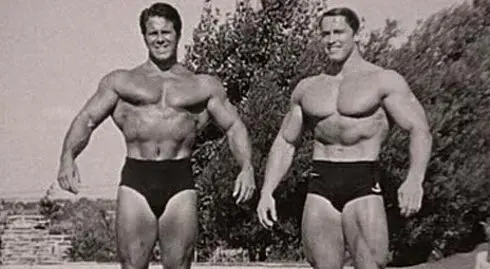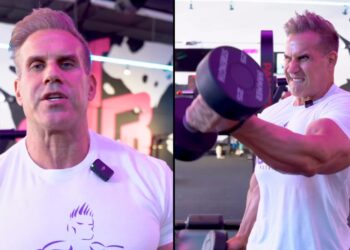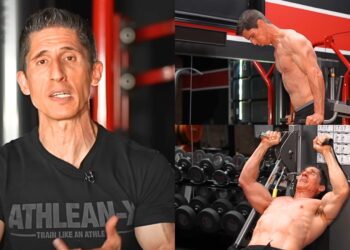Running It For Gains Made Easy
Why do it:
With rest-pauses, you extend a set by giving yourself more rest between reps, but sometimes doing some good hardcore drop sets, where you essentially don’t rest at all, is just what your pecs need to start growing. In this case, we’re dealing with dumbbell presses (either flat or incline bench), which means you’ll be running the rack. “This overload of continuous sets will really shock those stubborn pecs,” says Jim Ryno, owner of LIFT, a private personal training facility in Ramsey, New Jersey (inside lift. com). “This technique works best with virtually no rest between sets, so be sure to move quickly when changing weights.”
What to do:
On flat or incline dumbbell presses, select weights that you would normally lift for a set of eight reps. Complete the set as usual, but instead of stopping, immediately go back to the rack, take a pair of dumbbells that are 20 pounds lighter and rep those out to failure. Proceed down the rack in 20-pound increments, going to failure with each weight until you’re literally using 15-20-pound dumbbells.
Do this 2-3 times total as your last sets for compound exercises that day.
Partial Press
Why do it:
“If you stop a set due to your inability to complete a full rep, you’re not taking the muscle to its true limit,” says Jim Stoppani, PhD. “If instead, you continue with partial reps until you can no longer budge the weight, you’ll know you’ve taxed the muscle to its absolute limit.” For chest, partial reps are great on Smith machine presses, other chest press machines, and the dumbbell press. Since the triceps play a major role in the top half of the range of motion (ROM) when pressing, you often have to end the set when the triceps fail, not the chest. By doing reps in the lower half or three-quarters of your bench press ROM (after reaching full-ROM failure), your triceps are no longer the limiting factor and you can take your pecs to full fatigue.
What to do:
On the last set or two of any or all of the aforementioned exercises, go to full-ROM failure, then continue doing reps in the lower half to three-quarters of the ROM (all the way down, but stopping well short of full extension) until you can no longer push the weight to the halfway point.
 Pecs Admitted For Fatigue
Pecs Admitted For Fatigue
Why do it:
The pre-exhaustion technique, in which you do single-joint exercises before compound movements in a given workout (the opposite of what most people typically do), is especially useful for chest training. Reason being, the triceps often tire before the pecs on pressing exercises. By doing your isolation work first, you all but guarantee that the pecs will fatigue first, which, after all, is the whole point of training chest. Besides, anything different is a good bet for sparking new gains. “With this reverse order of exercises, you’ll hit the pecs in a unique way, giving your chest muscles a stimulus they’re not used to,” Ryno says.
Level Up Your Fitness: Join our 💪 strong community in Fitness Volt Newsletter. Get daily inspiration, expert-backed workouts, nutrition tips, the latest in strength sports, and the support you need to reach your goals. Subscribe for free!
What to do:
The next time you train chest, do all isolation exercises (cable crossovers, flyes, pullovers) first in your workout, making sure to exhaust your pecs by any means necessary training to failure using such techniques as drop sets, rest-pauses, etc. Follow that with your pressing moves (flat, incline or decline dumbbell and/or barbell presses). Exercise selection should go something like this: 2-3 isolation exercises followed by 2-3 compound moves.
The Dirt On Flye-Press Combos
Why do it:
This technique is great when you’re short on time, have only a few dumbbells available or just want to blast your pecs a little differently. It’s also a great way to use a heavier-than-normal weight when doing flyes, which can be a welcome break from using light dumbbells.
What this chest-shocker ends up being is something of an extended set, in which flyes steadily morph into presses as the pecs get more and more fatigued.
What to do:
Choose a set of dumbbells that will allow you to complete only 5-6 reps for flyes (on an incline, flat or decline bench). Perform as many reps of strict-form flyes as you can, then, after reaching failure, immediately change your form so you’re doing a cross between a flye and a neutral grip press at the bottom of each rep, your elbows will be somewhere between full extension and 90 degrees. Perform these to failure, then immediately change your hand position and perform standard presses to failure. Do a total of three sets in this manner, resting two minutes between each.
Why do it:
What better way to bust through a plateau than with a combination of intensity-boosting techniques, not to mention one of the most tried-and-true chest exercises out there the dip. As you’ll see, this pecshocker includes not only training to failure multiple times over the course of one laborious set but also negatives and drop sets (bodyweight dips). “This is one of my all-time favorite chest-shockers,” says Jimmy Pena, MS, CSCS. “When you do it, just make sure it’s near the end of your workout it’s that tough!”
What to do:
Select an additional amount of weight for weighted dips that’ll have you fail at 12-15 reps. After reaching failure, immediately switch gears and do as many negatives as possible with the same weight (for the positive portion of these reps, step up to the top). When you can no longer lower yourself under control for negatives, immediately strip the additional weight and rep out to failure with your bodyweight. That’s one set. Do this 1-2 more times.
Welcome Additions
Shocking a bodypart into growing can be as easy as adding new exercises to the mix. Here are four chest moves you probably haven’t done in a while, if ever.
 One-Arm Dumbbell Flye
One-Arm Dumbbell Flye
This is done with the same basic form that is used in two-arm flyes, only with a nonworking hand grasping a bench or stable object for balance. Cable flyes and crossovers can also be done one arm at a time.
One-Arm Machine Press
Whether on a Cybex or Hammer Strength machine, performing unilateral presses will help minimize chest imbalances.
Barbell Pullover
Most people prefer to perform pullovers with a dumbbell, which is fine. But incorporating a barbell into the move on occasion (with a shoulder-width grip) will hit the pecs from a slightly different angle.
Clap Push-Up
Power moves are great to include in your routine (in moderation) to help you bust through plateaus. After reaching the bottom position of the push-up, explode up as fast as you can so your hands literally leave the floor, then clap them together before coming back down.
Scandal! Push-ups For Mass?
Why do it:
Few bodybuilders seem to take advantage of the one chest exercise we all started out performing push-ups mainly because once you get some decent chest strength, you can bust out 20-50 reps without breaking a sweat. But that won’t be the case at the end of a grueling chest workout. By finishing things off with the following push-up tri-set, you’ll fry all areas of your chest by pushing fatigue to the limit.
What to do:
As soon as you complete the last set of your last exercise for chest, find a flat bench. Get into push-up position with your feet on the bench and your hands on the floor. Pump out as many reps as you can to blast your upper pecs, then immediately drop your feet to the floor and go to failure on standard push-ups to torch the middle pecs. After that, put your hands on the bench and your feet on the floor.
Crank out as many reps as you can to finish off your lower pecs, then call it a day.
Author: Weider
Copyright 2008 Weider Publications

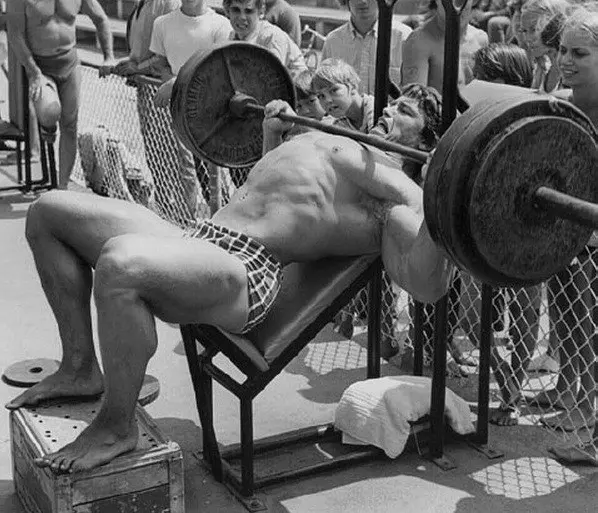 Pecs Admitted For Fatigue
Pecs Admitted For Fatigue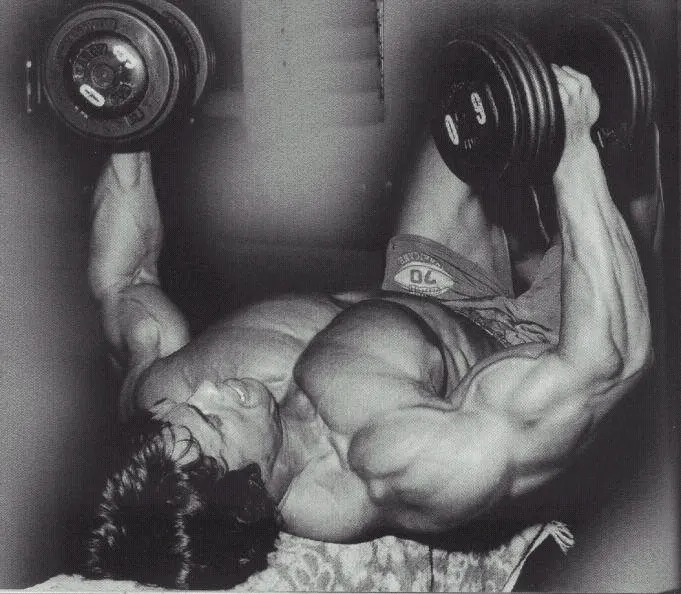
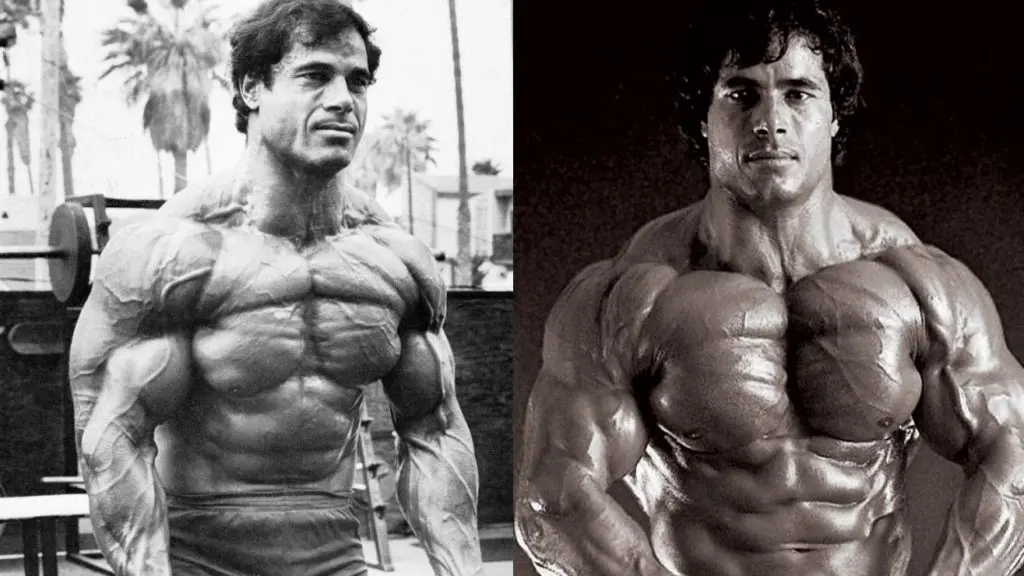 One-Arm Dumbbell Flye
One-Arm Dumbbell Flye